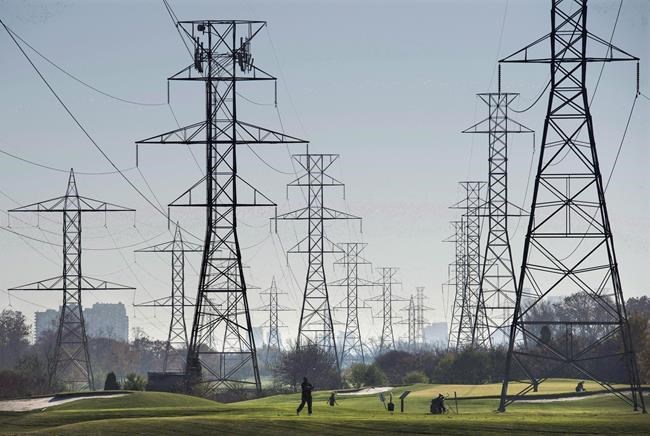TORONTO — Ontario's electricity system operator is planning to seek out more wind and solar power, five years after the Progressive Conservative government cancelled a slew of renewable energy contracts.
The Independent Electricity System Operator announced Monday that it is looking to bring 2,000 megawatts of non-emitting electricity generation online — such as wind, hydro, bioenergy and hydro — which would provide enough power for two cities the size of Ottawa.
The procurement planned for next year is set to be the first of a regular series to add 5,000 megawatts of electricity generation, over the next four to six years, to both meet Ontario's growing energy needs and work toward a zero emissions electricity grid.
The province's electricity demand is expected to grow by about two per cent each year, but could be even higher depending on electrification within the broader economy.
"With new supply on track to meet demand mid-decade, we are now addressing energy needs going into the 2030s and beyond,” IESO president and CEO Lesley Gallinger wrote in a statement.
Ontario has also recently been adding electricity storage projects, with an eye to about 2,500 megawatts, and the IESO said the province's emerging battery fleet will pair well with wind and solar, so that the power generated by those methods can be stored and injected into the grid when needed.
Premier Doug Ford cancelled 750 renewable energy contracts shortly after his Progressive Conservatives formed government in 2018, after the former Liberal government had faced widespread anger over the long-term contracts with clean power producers at above-market rates.
The IESO said this new process for green energy will be competitive, helping to ensure "that cost-effective proposals will be chosen."
"Current average benchmark prices for current competitively procured wind resources are less than half of the average rate for wind procured through the Feed-In-Tariff (FIT) program of the mid-2000s," the IESO wrote in a report to Energy Minister Todd Smith.
But securing all of that new renewable energy may not be a smooth process. Smith has required municipal council support for projects, and some communities have recently turned down new or expanded natural gas plants and the IESO has flagged "a growing incidence of unwilling hosts."
"In moving forward with this transformative effort, the IESO is working to understand the needs of communities and stakeholders across the province," the IESO wrote in its report Monday to the minister.
"Many communities are being asked to consider locating various types of projects that will support their needs but also have the potential to spark local opposition. Some will face a demanding task as serious and thoughtful decisions must be made about what works best for communities and our province as a whole."
Communities around the province have also expressed opposition to wind farms.
Smith said he would not repeat the mistakes of the Liberals' "disastrous" green energy policy that "forced" projects on municipalities.
"Our government has made municipalities full partners in energy planning," he wrote in a statement.
"Our competitive process will drive down costs and the requirement for a supportive council resolution will ensure successful projects benefit their local communities, ratepayers and Ontario’s grid as a whole."
The IESO has said natural gas is required to ensure supply and stability in the short to medium term, but that it will also increase greenhouse-gas emissions from the electricity sector.
A report late last year by the IESO found that the province could fully eliminate natural gas from the electricity system by 2050, starting with a moratorium in 2027, but it will require about $400 billion in capital spending and more generation including new, large-scale nuclear plants.
Smith is moving forward with exploring a new, large-scale nuclear plant at Bruce Power on the shore of Lake Huron and several small modular reactors, but has not committed to a natural gas moratorium or phase-out by 2050.
Advocacy group Environmental Defence said it is pleased the IESO is planning to acquire more renewable generation, but said it should also abandon its gas procurement entirely.
"These gas plants that the IESO is seeking to procure will come at great expense though they will be effectively shut down in 2035, just seven years after they are to come online, due to the forthcoming federal Clean Electricity Regulations," programs director Keith Brooks wrote in a statement.
"Ontario ratepayers will save billion of dollars if the IESO shelves this procurement now, before offering any more contracts."
This report by The Canadian Press was first published Dec. 11, 2023.
Allison Jones, The Canadian Press

